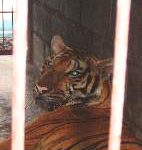South Africa is witnessing a massive surge in rhino poaching, an activity blamed on criminal syndicates striving to meet an “insatiable appetite” for rhinoceros horn in east Asia.
Eighty-four rhinos have been killed by poachers in the country so far this year, a jump from the 13 deaths in 2007.
Kruger National Park, a worldwide tourist attraction, has been hardest hit, suffering the loss of 33 rhinos since January. Nineteen have been killed in KwaZulu-Natal province, and some privately owned reserves have lost seven animals.
Conservationists say it is the biggest spike in poaching for 15 years and blame the smuggling trade connected to countries, such as China and Vietnam, where rhino horn can fetch thousands of dollars for its perceived medicinal value.
They say that Asian countries’ strengthening trade links with Africa have shortened the illegal supply chain. They also say more sophisticated poaching methods are being used, with organised criminal gangs flying in to game reserves by helicopter to kill rhinos, hack off their horns and make a quick getaway.
South Africa has about 1,490 black rhinos, more than a third of the world population of this critically endangered species. There are about 16,275 southern white rhinos, 93% of the global total.
Yolan Friedmann, chief executive of the Endangered Wildlife Trust (EWT), said the number of rhinos lost to poaching had altered from an average of 10 a year to 100. “There has been a rampant increase in South Africa,” she said. “Poaching figures for this year have already surpassed the whole of last year. It’s probably the worst it’s been for 15 years. There’s a lot more money going into poaching and it’s becoming more high-tech. It’s no longer just a man with a bow and arrow wading through the bush. These guys are using helicopters and AK-47 rifles.”
She warned that initiatives used previously could not meet the new threat. “Despite the once-successful Save the Rhino project, rhinos are under siege. South Africa is facing a crisis. We’ve done extremely well in rhino conservation, but something has changed in the past 18 months; there’s an insatiable appetite for rhino horn in the far east.”
Ground up and added to liquids, rhino horn has been used for millennia in traditional Asian medicine to treat fevers and other ailments.
Rumours have recently been circulating on the internet that a Vietnamese government official claimed rhino horn cured his cancer, potentially fuelling demand.
Last year a Vietnamese diplomat was caught on camera taking delivery of contraband rhino horn outside the Vietnamese embassy in Pretoria.
There is also a lucrative market in Yemen and Oman for daggers with rhino-horn handles‚ frequently given to boys during rites of passage.
Poaching gangs, often from nearby countries, are believed to earn about US$200 a horn, but once the material has been transported, ground and mixed with other substances it can sell for thousands of dollars on the black market. Poachers’ sentences and fines are usually negligible.
Friedmann said that seemingly legitimate parties also exploited loopholes. “Their hunting permits say they are only allowed to mount the rhino horns on the wall but we’re finding they use the byproducts to sell illegally. Price is not an issue. A hunt was sold last year to Vietnamese hunters for more than one million South African rand [US$136,000]. That’s a record price for white rhino.”
Luxury private game reserves seem to have been caught out by the upsurge; many employ guards, but the men tend to lack training in wildlife protection.
In July a meeting in Geneva of the Convention on International Trade in Endangered Species (CITES) heard that rhino poaching around the world was set to reach a 15-year high, and there was growing evidence of Vietnamese, Chinese and Thai nationals’ involvement in the illegal procurement and transport of horn out of Africa.
The South African government has been criticised for disbanding the police’s endangered species protection unit in 2003. But Buyelwa Sonjica, the environmental affairs minister, recently announced the formation of a special investigations team to tackle poaching.
South African National Parks has said it will spend two million rand [US$272,000] to provide an additional 57 game rangers in Kruger park and equip them with motorbikes. Patrols along the park’s 450-kilometre South Africa and Mozambique border, where all 33 poached rhinos were killed, are also set to resume after being suspended three years ago.
At least 14 poachers, all Mozambican, have been arrested and several illegal firearms seized in Kruger this year. Nationwide, 22 poachers were caught. In January an international rhino-smuggling ring was smashed and 11 people were arrested.
Rhino numbers have been increasing worldwide thanks to various governments and NGOs. But Cathy Dean, director of the UK-based Save the Rhino International, warned: “The gains of the last decade are in real jeopardy. The underlying concern is that this upsurge in rhino poaching – a major issue in Zimbabwe as well as South Africa – is no longer opportunistic poaching by individuals but carried out by … highly sophisticated criminal gangs.”
www.guardian.co.uk/
Copyright Guardian News and Media Limited 2009
Why poachers target the rhino
A combination of ancient Chinese belief and modern financial speculation help to explain why rhinoceros populations are coming under renewed pressure from poachers.
In traditional Chinese medicine, rhino horn is prized as a key ingredient in An Gong Niu Huang Wan, considered one of the three main restorative tonics. Shaved or ground into a powder, the horn is dissolved in boiling water and used to treat fevers, rheumatism and gout.
The Chinese government banned the trade in rhino horn in 1993 at the same time as it imposed a similar prohibition on the sale of tiger body parts. Since the ban, the horn of water buffalo has been used as a substitute, but it is not considered as effective.
On the internet, sales continue of rhino-based An Gong Niu Huang Wan with claims that the product is made with horn stockpiled before the ban.
Chinese and Vietnamese buyers prefer horn from Asian rhinos, which is three to six times more expensive than that of African animals. But poaching and habitat loss mean there are few rhinos left in Asia, which is what could have prompted the dealers to look for supplies in Africa.
Last May, an official of the Convention on International Trade in Endangered Species (CITES) visited south-east Asia to appeal to enforcement authorities to pay extra vigilance to rhino horn smuggling.
“The Vietnamese are moving rhino horn from Africa. That’s something we haven’t seen before,” noted an Asia-based conservationist, who asked to remain anonymous. “There is stockpiling. Collectors appear to be holding on to the horn like gold and waiting for the value to increase.”
Assessment of the extent of the problem is complicated by the tendency of smugglers to mix rhino horn with elephant tusks. A big shipment of ivory bound for Bangkok — seized in Kenya in September — is believed to have included rhino horn.
While the majority of rhino products are made in China and Vietnam, the animal’s horn also fetches a good price in Yemen, Oman and other countries in the Middle East, where it is carved to produce dagger handles.
— By Jonathan Watts
www.guardian.co.uk/
Copyright Guardian News and Media Limited 2009
Homepage image by Arno & Louise



